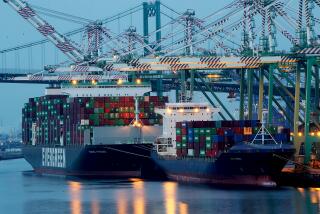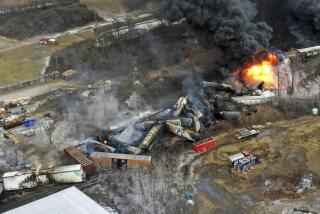Union Pacific Problems Draw State, U.S. Scrutiny
- Share via
Contending that continued rail service problems on the massive Union Pacific system threaten California’s economy, state officials today plan to urge the federal Surface Transportation Board to impose sanctions on the railroad and to open its lines to competitors if the crisis is not resolved soon.
On Tuesday, the National Transportation Safety Board announced plans to hold hearings on the safety record of the nation’s largest railroad. “We’ve investigated 14 Union Pacific accidents in the last 12 months,” said Robert C. Lauby, chief of the NTSB’s railroad division. “That’s way out of line with other railroads.”
Southern Pacific’s problems have forced so many shippers to divert cargo away from the ports of Los Angeles and Long Beach that in November the two harbors recorded the fewest ship arrivals of any month since 1976--just 393.
While ships are no longer backed up in Los Angeles and Long Beach harbors, a top official with the California Public Utilities Commission says in a statement to be presented at today’s hearing in Washington that “the situation in California is still unacceptable.”
Robert F. Starzel, vice president of the western region for Union Pacific, insisted Tuesday, however, “We’ve made great progress. . . . This was a big mess, and you don’t pull out of a big mess overnight.”
Larry Keller, executive director of the Port of Los Angeles, credited Union Pacific with making improvements such as adding locomotives and work crews to the rail network but said, “They’ve got a long way to go.”
The rail backup and labor shortage are no longer stranding cargo ships in the outer harbor, Keller noted, but the rail car shortage has left containers stacked up in most of the shipping terminals at both ports.
“Now it’s a matter of working the congestion off the terminals,” he said.
Today’s hearing was called by the Surface Transportation Board to review Union Pacific’s progress in resolving what government officials declared in October to be a “transportation emergency” on the railroad’s 36,000-mile system throughout the West.
The traffic jam caused ships to back up at the local ports, forced shippers to divert vessels to other harbors, delayed commuter trains and held up chlorine needed to treat the region’s water supply.
The Metropolitan Water District of Southern California, which was forced to send tanker trucks to Nevada to bring back chlorine, reported Tuesday that rail service has improved and that it no longer considers the situation an emergency. But the water agency urged federal authorities to consider creating a prioritized list of goods that would take precedence in rail emergencies.
Some shippers reported that congestion is still delaying cargo. “We’re nowhere near what we used to be able to do,” said Gunnar Gose, transportation manager for Kawasaki Kisen Kaisha Line, which calls on the Port of Long Beach.
With export-bound cargo delayed up to a week and import-bound cargo also running behind, the company has diverted scores of containers from rail to trucks.
At American President Lines, which calls on the Port of Los Angeles and claims to be the railroad’s largest customer, officials say they see signs of progress. For the first time in 10 weeks, some Union Pacific trains are running ahead of schedule, and officials of the shipping line said the average speed of trains had edged up. “We are in no way back to normal stability,” said Pete Baumhefner, director of stack-train operations. But he said the recent improvements represented “a big, big jump in the right direction.”
Port of Long Beach officials said the situation had improved, and that delays of two weeks or more experienced by some customers had been substantially reduced. And, to deal with the labor shortage that exacerbated the rail congestion, port officials have encouraged the hiring of more longshoremen.
The railroad’s “recovery plan” says lingering problems in Southern California have had an impact on shippers elsewhere, particularly lumber shippers in the Pacific Northwest who need cars that are tied up here.
*
“We’re hanging on by the skin of our teeth,” said Steve Beckley, executive vice president of the Sacramento-based California Fertilizer Assn. While the congestion appears to have eased somewhat, he said orders that once took 10 days to deliver may now take up to 40.
And at the major rail yard near the Los Angeles-San Bernardino county line, 3,000 rail cars waited to be loaded onto trains Tuesday, up from the usual 1,800 to 2,000. But Union Pacific officials said rail cars are being moved along at a much faster rate.
The PUC said in its statement, obtained Tuesday, that the railroad’s recovery plan has not resulted in a return to normal rail operations in California.
State officials said that while there has been much focus on problems in Texas and the Gulf Coast, troubles in California--the principal gateway to the Pacific Rim and the largest food-producing state--affect not only California’s economy but also the nation’s.
The problems have been blamed on Union Pacific’s merger with Southern Pacific last year.
According to the PUC, computer systems used by Union Pacific and Southern Pacific were incompatible, resulting in rail cars “lost” in the system. A management buyout of Southern Pacific employees resulted in a critical shortage of experienced managers able to deal with the crisis. “In California, the railroad is thus still being operated as essentially two systems,” said the PUC statement.
Union Pacific officials blamed problems in part on Southern Pacific’s failure to upgrade its system over the years to accommodate the growth in freight traffic.
PUC officials plan to urge federal authorities to set deadlines for Union Pacific to improve service, impose sanctions if problems persist, require the railroad to report weekly on the status of recovery efforts in California and seek a management audit of the railroad.
Times staff writers Eric Malnic and James F. Peltz contributed to this story.
More to Read
Sign up for Essential California
The most important California stories and recommendations in your inbox every morning.
You may occasionally receive promotional content from the Los Angeles Times.











